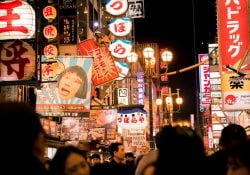The へ, に and で particles have big differences, but sometimes it can be difficult to know which one to use. In this article, we will see some examples and occasions for this doubt to be explained.
Índice de Conteúdo
particle へ
The particle へ(e) is used to indicate the direction of an action, similar to the Portuguese “para”. It is also used to indicate the person (or thing) to whom the action is directed.
- I go to school;
- 2階へ行きます (nikai and ikimasu) I'm going to the second floor
- Remembering that it can be, I will, go and let's go depending on the context of the conversation;
particle に
The particle に (ni) has many different grammatical functions, with it is possible to indicate existence, location, destination, direction of an action, space of time and many other things.
- There are fish in the sea.
- Come to my house.
- Show it to the police.
Particle で
The particle で (de) indicates where an action is taking place or has taken place. It is often used in conjunction with Japanese nouns, such as names of places, people, animals, or objects, adding more information about how that action is performed. In a simple way we can say that the particle represents the place where the action occurs or with what the action is done.:
- I study at school.
- We will go by train.
- ふとんで寝ます。(nemasu's futon.) Let's sleep on the futon
The article is still halfway through, but we recommend also reading:
へ (e) - to に (ni) - at, in, to
There are some situations where both particles have the same meaning in the sentence, both are used to indicate destination or direction. On occasions like this, either of the 2 can be used, it will be correct and it will have the same meaning. Examples:
- I'm going home.
- 家へ帰ります。(uchi and kaerimasu)
Both phrases are correct and means: “to return (return) home”. But in situations like welcoming someone somewhere it is better to use the へ particle.
- 日本へようこそ。(Nihon and Yokoso.) Welcome to Japan.
These two particles are used to express a direction, but the に particle is more specific than the へ particle. While に (ni) defines a precise location, the particle へ (E) defines yet another area. Example:
- I am going to my company.
- I will go to Japan next year.
To further simplify the situation we should keep in mind that へ indicates direction and に indicates destination. And that the に particle places an emphasis on location while the へ particle places an emphasis on movement or direction.
に and で are both Japanese particles that indicate location or time in a sentence. に is often used to indicate the destination of an action, while で is often used to indicate the location where an action takes place.
The Japanese particle へ (he) and the particle に (ni) have similar functions but are used in different contexts.
The particle へ (he) is used to indicate movement or direction. For example:
- 東京へ行きます。 (Tōkyō e ikimasu. – I'm going to Tokyo.)
- 映画館へ行きます。 (Eigakan and ikimasu. – I'm going to the movies.)
The particle に (ni) is used to indicate place or time. For example:
- 明日に会いましょう。 (Ashita ni aimashō. – Let's meet tomorrow.)
- 友達に会いに行きます。 (Tomodachi ni ai ni ikimasu. – I'm going to meet a friend.)
In addition, the particle に (ni) is also used to indicate means or goal. For example:
- 車に乗ります。 (Kuruma ni norimasu. – I'll go by car.)
- バスに乗ります。 (Basu ni norimasu. – I'll take the bus.)
Both particles are used to indicate a place. But the particle で is used together with an action verb. Already the particles no or and are used together with a verb of direction.
- 公園で食べる。 (taberu kouen.) Eating in the park
- 公園に行く。 (kouen ni iku.) Go to the park
Of course there will be identical phrases, you have to decide which of the particles to use. See the sentence below:
- ベッドに横たわる。
- ベッドで横たわる。
- Bed _ Yokotawaru;
Both phrases mean to lie down in bed. What's the difference? When you focus on the action (sleep) you use で (de), when you focus on the place where you are going to sleep, you use に (ni).
So there is no reason to confuse the use of the particle, just remember that the に particle indicates the location or when an action is performed in a certain direction. And that the particle で indicate the place where some action takes place. And the へ particle indicates the movement or direction. I hope this article has helped you and clear your doubts, enjoy and leave your comments and example sentences to help readers.






